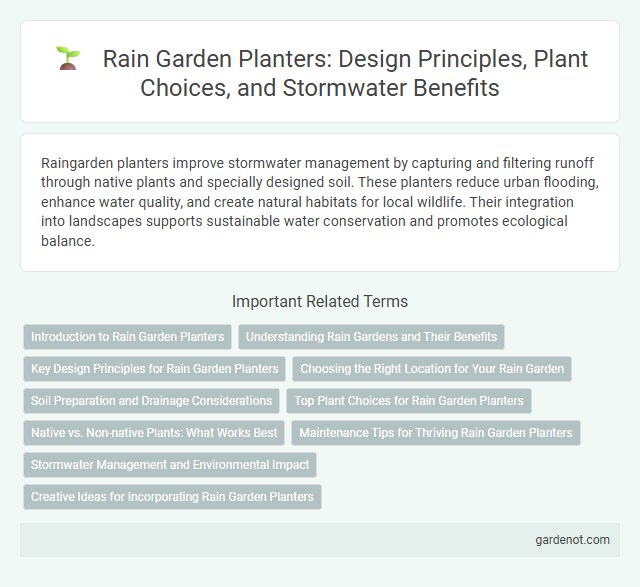Raingarden planters improve stormwater management by capturing and filtering runoff through native plants and specially designed soil. These planters reduce urban flooding, enhance water quality, and create natural habitats for local wildlife. Their integration into landscapes supports sustainable water conservation and promotes ecological balance.
Introduction to Rain Garden Planters
Rain garden planters are specially designed containers that replicate natural rain gardens by capturing and filtering stormwater runoff. These planters use native plants and engineered soils to reduce pollutants, mitigate flooding, and improve water quality in urban environments. Incorporating rain garden planters supports sustainable landscaping and enhances ecosystem resilience while promoting efficient water management.
Understanding Rain Gardens and Their Benefits
Rain garden planters effectively manage stormwater by capturing and filtering runoff, reducing pollutants entering waterways. These planters enhance urban green spaces by supporting native plants that improve biodiversity and increase groundwater recharge. Properly designed rain garden planters mitigate flooding and soil erosion while promoting sustainable water management practices.
Key Design Principles for Rain Garden Planters
Rain garden planters must prioritize proper soil composition with a mix of sand, compost, and topsoil to ensure effective water infiltration and plant health. Incorporating native, water-tolerant vegetation enhances pollutant filtration and supports local biodiversity. The planter's depth and slope are critical, designed to capture stormwater efficiently while preventing overflow and promoting gradual absorption.
Choosing the Right Location for Your Rain Garden
Selecting the optimal site for a raingarden planter involves identifying low-lying areas that naturally collect runoff while ensuring proper drainage to prevent standing water. Position the planter at least 10 feet away from building foundations to avoid water damage, and choose a spot that receives adequate sunlight for the plants to thrive. Soil type is crucial; sandy or loamy soils facilitate better infiltration compared to clay-heavy soils, enhancing the rain garden's effectiveness in managing stormwater.
Soil Preparation and Drainage Considerations
Raingarden planters require well-draining soil composed of a mix of sandy loam, compost, and topsoil to optimize water filtration and prevent root rot. Proper soil preparation includes loosening the soil to a depth of 12-18 inches to enhance infiltration and support native plant roots. Incorporating gravel or a drainage layer beneath the soil ensures excess water is efficiently dispersed, reducing surface runoff and promoting sustainable stormwater management.
Top Plant Choices for Rain Garden Planters
Selecting the right plants for rain garden planters involves prioritizing native species that thrive in both wet and dry conditions, such as blue flag iris, swamp milkweed, and cardinal flower. These plants enhance water absorption while supporting local biodiversity, attracting pollinators like bees and butterflies. Incorporating deep-rooted perennials and grasses like switchgrass and sedge helps stabilize soil and improve filtration efficiency.
Native vs. Non-native Plants: What Works Best
Rain garden planters thrive with native plants due to their deep root systems, which enhance water absorption and support local wildlife, making them more effective in managing stormwater runoff. Non-native plants often struggle to adapt to local soil and climate conditions, potentially requiring more maintenance and disrupting ecosystem balance. Selecting native species like switchgrass, blue flag iris, or butterfly weed ensures sustainable growth and optimal environmental benefits in rain garden planters.
Maintenance Tips for Thriving Rain Garden Planters
Rain garden planters require regular maintenance such as consistent watering during dry spells, mulching to retain soil moisture, and removing weeds to prevent competition for nutrients. Monitoring plant health and pruning dead or damaged foliage promotes vigorous growth and enhances water absorption. Seasonal inspections ensure proper drainage and prevent soil compaction, supporting a thriving, sustainable rain garden planter.
Stormwater Management and Environmental Impact
Raingarden planters effectively capture and filter stormwater runoff, reducing pollutants and preventing excess water from overwhelming urban drainage systems. By promoting infiltration and natural filtration, these planters mitigate flooding risks and improve groundwater recharge. Their environmental impact includes enhancing biodiversity, reducing erosion, and supporting sustainable urban ecosystems through habitat creation.
Creative Ideas for Incorporating Rain Garden Planters
Rain garden planters offer an innovative solution for managing stormwater runoff while enhancing landscape aesthetics. Incorporate native plants like sedges, ferns, and wildflowers in tiered or container designs to maximize water absorption and support local biodiversity. Utilize recycled materials such as reclaimed wood or metal pots to create sustainable, visually appealing rain garden planters that blend seamlessly with urban or residential environments.
Raingarden planter Infographic

 gardenot.com
gardenot.com